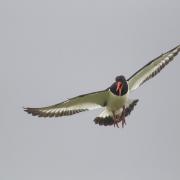Paul Hobson investigates an endearing woodland bird that visits our gardens in winter

One of my greatest pleasures when I work with woodland birds photographically is that I often get to know individuals, and from such close observation find out about their character.
Perhaps because of their size some birds, coal tits for example, are right at the bottom of the pecking order. However, they compensate for this by being fleet of wing and what we would call ‘cheeky’. From their point of view it’s a case of ‘needs must’ when they whizz in under the beaks of more dominant cousins like the great tits to snatch a sunflower seed from the bird table. Robins are always pugnacious and like nothing better than to get stuck into a skirmish either with another robin or an innocent finch. Sometimes these hold their own ground and lean forward, bill held open threateningly until the robin backs down.
As the winter progresses the behaviour of all birds changes as natural food larders run down and the bird table becomes the focus of life-giving energy foods. Starvation is a powerful motivating force to run the gauntlet of the robin that thinks the table is solely for its own use.
One bird that often visits bird tables in Derbyshire, especially since many of us now use black sunflower seeds, is the nuthatch. These are incredibly attractive small birds bursting with character and attitude. Nuthatches are found in woodland in Derbyshire throughout the year but we tend to notice them most in winter when they start to work the bird tables in their home range. If the season is particularly harsh they will band together with gypsy groups of roving tits and venture further from the woods.

During the rest of the year they are still working hard in many woodlands but we tend not to notice them unless we learn their very loud, boyish whistle, which when heard is easy to remember. Then you start to realise just how widespread they are. Nuthatches or as they were called in days past, nutjobber or nuthacks, are well named. The clue is clear, nuts because they have a special liking for those tasty kernels. In a truly wild situation they will feast on beech mast in good years (something I used to do as a boy), and native hazel nuts. They can also winkle out the paper thin seeds from fir cones.
Today they are intelligent birds that quickly find bird tables laden with sunflower seeds. At the bird table they have a distinctive style of their own. They often don’t actually feed at the table but fly in with a speedy undulating flight, rapidly cram as many sunflower seeds as they can down their gullet, and leave as quickly as they arrived. They often tend to get into a pattern and will return very quickly for up to ten or 20 visits. The time interval between these can be so short it begs the question, just how fast can they extract the sunflower kernel from the seed and eat it? The answer is simple, they aren’t eating them but storing them up somewhere else, to eat at a later time.
It’s a clever strategy, to make hay while the sun shines, but I often play a few tricks on them so that they will stay longer. I set up branches with splits in them and cram either sunflower seeds or hazel nuts in. It does not take long before they find them and hammer the tasty kernel out. Hazel nuts clearly take longer! When they fly to a branch they often stop for a quick glance around then in short bursts run down it in a manner very similar to a woodpecker’s – though they only run up branches.
During the nesting season nuthatches have a unique way of reducing predation of their chicks from larger nest robbers like grey squirrels or woodpeckers. They cement up their hole, just leaving a gap big enough to enter. This means they can use natural holes where branches have dropped that would normally be unsuitable. They can’t drill their own holes like woodpeckers. I read once that one pair of nuthatches nested in the side of a hayrick and used so much clay surrounding the nest that it weighed 5kg!

There is only one species in the nuthatch family in Britain though in Europe there are a couple of other ones – the rock nuthatch and Kruper’s nuthatch. The latter was named after the German naturalist Dr Kruper. There is a tenuous link with Derbyshire here in that Henry Seebohm, a Sheffield steel manufacturer, visited Dr Kruper in the 1880s in Turkey where he then lived. Seebohm went on to become one of the most important ornithologists in Britain and he cut a lot of his birding teeth in Derbyshire during the 1860s and 70s.
Nuthatches are stunning little birds with bags of appeal. They are easy to get to bird tables in winter if you live near woodlands, particularly if you stock up with black sunflower seeds. If you want to get them to hang around longer and give you hours of fun, try wedging a series of hazel nuts into cracks in the trees in your garden. If you don’t have any trees, try using a large fallen branch and propping it upright. It’s well worth the effort.



























